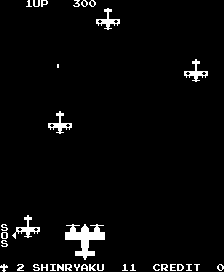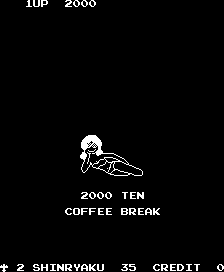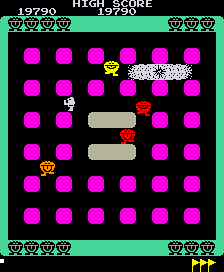Games on the same hardware as the funny sassy lemon on legs blepping eternally
Gee Bee - Bomb Bee - SOS – Cutie Q – Kaitei Takara Sagashi – Navarone – Tank Battalion – Warp & Warp
Gee Bee – 1978 - Personal high score: 44220
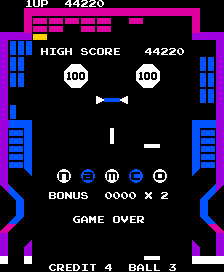 A combination of Pinball and Breakout into one game, made as a compromise by the designer who wanted to make pinball tables but didn’t have the approval of Namco’s higher-ups. Gee Bee differentiates itself from Breakout with a more complex scoring system, this being where the pinball influences show the most. Bumpers award 10 points, but breaking all the bricks on their side of the board increases their value to 100 points. You’re awarded bonuses after each life lost depending on how many bricks you break, and that bonus value can be multiplied by lighting up all the NAMCO letters at the bottom of the board, which switch on and off as your ball passes over it. You have control over two paddles, the top paddle being used for breaking bricks and hitting the bumpers while the bottom paddle is used for lighting up the NAMCO letters and as a back-up should you miss the ball with the top paddle. Using the bottom paddle is significantly more risky due to the presence of gutters which your paddle can not reach, resulting in an instant lost life should your ball fall down them, though these gutters can be blocked off by breaking all the bricks that increase the bumpers points value. The game speeds up quickly and the ball is somewhat unruly to control, how quickly the ball speeds up has a lot of variables that results in the ball speed feeling a bit random and resulting in plenty of games where the ball gets to an uncontrollable speed within seconds of starting. The ball can be slowed down by shooting it through the spinner in the middle of the table, giving the game a flow of carefully aiming shots with the ball until it gets too fast for you to keep up with, then doing your best to keep juggling it until you manage to shoot it through the spinner, upon when you go back to aiming your shots.
A combination of Pinball and Breakout into one game, made as a compromise by the designer who wanted to make pinball tables but didn’t have the approval of Namco’s higher-ups. Gee Bee differentiates itself from Breakout with a more complex scoring system, this being where the pinball influences show the most. Bumpers award 10 points, but breaking all the bricks on their side of the board increases their value to 100 points. You’re awarded bonuses after each life lost depending on how many bricks you break, and that bonus value can be multiplied by lighting up all the NAMCO letters at the bottom of the board, which switch on and off as your ball passes over it. You have control over two paddles, the top paddle being used for breaking bricks and hitting the bumpers while the bottom paddle is used for lighting up the NAMCO letters and as a back-up should you miss the ball with the top paddle. Using the bottom paddle is significantly more risky due to the presence of gutters which your paddle can not reach, resulting in an instant lost life should your ball fall down them, though these gutters can be blocked off by breaking all the bricks that increase the bumpers points value. The game speeds up quickly and the ball is somewhat unruly to control, how quickly the ball speeds up has a lot of variables that results in the ball speed feeling a bit random and resulting in plenty of games where the ball gets to an uncontrollable speed within seconds of starting. The ball can be slowed down by shooting it through the spinner in the middle of the table, giving the game a flow of carefully aiming shots with the ball until it gets too fast for you to keep up with, then doing your best to keep juggling it until you manage to shoot it through the spinner, upon when you go back to aiming your shots.
Gee Bee is unique and enjoyable, however my personal preference lies in its sequels. Bomb Bee is more akin to an update than a new game and results in Gee Bee feeling somewhat redundant. Bomb Bee is also far more forgiving, the ball is easier to control and the gutters are blocked off from the start, so if you want a more intense game then Gee Bee may still be worth playing as well.
Bomb Bee - 1979 - Personal high score: 71930
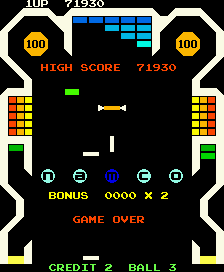 As I alluded to prior, Bomb Bee is Gee Bee but just straight up better. The board appears very similar to Gee Bee’s at first glance but there’s a few subtle changes that result in far more high scoring potential. The bumpers are now tucked away in corners, hitting the ball into those corners can result in the ball getting bounced back and forward between the bumper and the corner of the table repeatedly, racking up fast points. On top of this, there’s a new 1,000 points bumper that appears at the top of the board if you break all of the blue bricks. This gives amazing amounts of points super fast, but also speeds your ball up far faster than any other obstacle on the board, resulting in the whole flow of the game going far faster with repeatedly bouncing back and forward between the 1,000 bumper and then trying to aim for the spinner as quickly as possible to slow the ball back down. The multiplier earned from the Namco letters is also tweaked. Now after lighting up all the letters and getting the x2 multiplier, you can light them up again for a x3 multiplier too. It’s more or less the same game, but the tweaks made here to the scoring system, multipliers and slight alterations to the board shape itself all make for a significantly more engaging game, which further embraces the pinball inspirations that Gee Bee was born from and runs with them. Bomb Bee gives me a similar sense of excitement to what I get with pinball, when you start getting multipliers and you really want this ball to last as long as possible to keep this chain going. While far more forgiving than Gee Bee overall, Bomb Bee often gets more intense just because a x3 multiplier being at stake if you lose the ball is significantly more of a make or break deal on if you’re breaking your high score. Genuinely an excellent game I have no qualms with considering a classic alongside Namco’s more well known early output.
As I alluded to prior, Bomb Bee is Gee Bee but just straight up better. The board appears very similar to Gee Bee’s at first glance but there’s a few subtle changes that result in far more high scoring potential. The bumpers are now tucked away in corners, hitting the ball into those corners can result in the ball getting bounced back and forward between the bumper and the corner of the table repeatedly, racking up fast points. On top of this, there’s a new 1,000 points bumper that appears at the top of the board if you break all of the blue bricks. This gives amazing amounts of points super fast, but also speeds your ball up far faster than any other obstacle on the board, resulting in the whole flow of the game going far faster with repeatedly bouncing back and forward between the 1,000 bumper and then trying to aim for the spinner as quickly as possible to slow the ball back down. The multiplier earned from the Namco letters is also tweaked. Now after lighting up all the letters and getting the x2 multiplier, you can light them up again for a x3 multiplier too. It’s more or less the same game, but the tweaks made here to the scoring system, multipliers and slight alterations to the board shape itself all make for a significantly more engaging game, which further embraces the pinball inspirations that Gee Bee was born from and runs with them. Bomb Bee gives me a similar sense of excitement to what I get with pinball, when you start getting multipliers and you really want this ball to last as long as possible to keep this chain going. While far more forgiving than Gee Bee overall, Bomb Bee often gets more intense just because a x3 multiplier being at stake if you lose the ball is significantly more of a make or break deal on if you’re breaking your high score. Genuinely an excellent game I have no qualms with considering a classic alongside Namco’s more well known early output.
SOS – 1979 - Personal high score: 7240
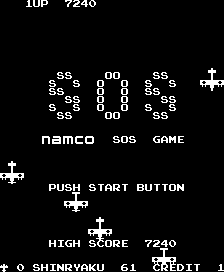 It’s hard to be too critical of a game from the 70s where the concept of a video game was still so young and the very concept of moving images on a monitor forming a game was still a novelty in itself. With that said, here’s SOS, a terrible game from the 70s. I don’t feel too guilty saying that, this was released in the same month as Galaxian and a year after Gee Bee, both of which are infinitely more enjoyable and hold up far better in their elegant simplicity. SOS by contrast is far more dull. You control a plane which can only move left and right very slowly at the bottom of the screen, while hordes of completely identical planes fly down in a completely straight line, never even firing at you or moving any direction other than straight down, you shoot them and you avoid crashing into them. The whole game feels extremely lifeless, even something like Space Invaders had more engaging enemy patterns and AI back in 1978, as well as having more than one enemy sprite copy-pasted endlessly. Another annoyance is that upon shooting an enemy plane they will explode into a puff of smoke (curiously, the best animated sprite in the whole game) which can actually still damage you. This means that enemies are capable of destroying you after you’ve already destroyed them. Since you move so slow, moving out of the way of said smoke cloud is often significantly more difficult than you’d expect.
It’s hard to be too critical of a game from the 70s where the concept of a video game was still so young and the very concept of moving images on a monitor forming a game was still a novelty in itself. With that said, here’s SOS, a terrible game from the 70s. I don’t feel too guilty saying that, this was released in the same month as Galaxian and a year after Gee Bee, both of which are infinitely more enjoyable and hold up far better in their elegant simplicity. SOS by contrast is far more dull. You control a plane which can only move left and right very slowly at the bottom of the screen, while hordes of completely identical planes fly down in a completely straight line, never even firing at you or moving any direction other than straight down, you shoot them and you avoid crashing into them. The whole game feels extremely lifeless, even something like Space Invaders had more engaging enemy patterns and AI back in 1978, as well as having more than one enemy sprite copy-pasted endlessly. Another annoyance is that upon shooting an enemy plane they will explode into a puff of smoke (curiously, the best animated sprite in the whole game) which can actually still damage you. This means that enemies are capable of destroying you after you’ve already destroyed them. Since you move so slow, moving out of the way of said smoke cloud is often significantly more difficult than you’d expect.
To be fair, there’s a couple of interesting mechanics of note. First off, if you are moving left or right when you fire a shot, that shot will be curved in the direction you’re moving. If you fire at a standstill you’ll just shoot straight ahead, which is a lot easier to aim, especially when all that the enemies do in this game is move in a straight line straight into your own straight projectiles, but again, because your plane’s movement speed is so slow, being able to fire these curved diagonal shots at enemies without having to position yourself directly underneath them can be a hugely beneficial time saver. This ties into the other mechanic of note, that being that if 100 planes fly by you unscathed you will get an instant game over, not even extra lives will save you. This is why the curved shots are such an interesting mechanic, because once enemies come in with larger swarms than you can rush back and forward between to shoot straight at, any time saved by not having to slowly inch your own plane across the screen can be a lifesaver. If you miss however, that will cost you potentially even more time than if you were to move under the enemy plane and shoot straight instead, as you can only have one fired projectile on screen at a time in typical Galaxian fashion. How many planes have flown past you is kept track of at the bottom of the screen (the number next to “SHINRYAKU”, shinryaku being the Japanese word for invader) letting you know how close you are to 100, but you can also lower this number value by answering SOS calls. These are played out in audio through morse code while the letters S O S flash on either the bottom left or bottom right of the screen. Flying over to the S O S signal will reduce the shinryaku value by 9. Speaking of audio, for whatever reason the game decided the most important sound effect to depict was the sound of plane propellers, meaning that the only sound you hear for most of the game is droning ear-piercing vibrations, followed by occasional shrill morse code. There’s no sound effects for firing or destroying planes, adding to the lifeless feel.
The only other thing of note is the Coffee Break screens. These happen every 2000 points, the game cuts to an an image of a girl in a bikini while the game pauses for a bit, giving the player a chance to catch their breath. If you manage to score 6000 points, you get to see her take off her bikini top, so if you want to see some high quality lewds that could be rendered on a calculator, this is your game! I’m ashamed to admit that I would of dropped this far sooner if not for the fact that I wanted to grab a screenshot of the nudity, requiring me to get good enough at this game to achieve 6000 points. I'd share, but I'm not risking getting my site flagged as adult this early on. Overall, SOS is more on the level of a Game & Watch game than even Namco’s earliest arcade output, though with slightly more single-pixel nipples being present.
Warp & Warp - 1981 - Personal high score – 61740
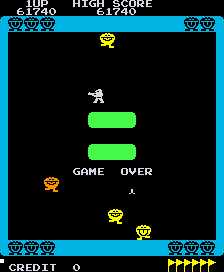 First off, Warp & Warp has one of the most hilariously adorable retro game sprites I’ve ever seen. Look at that sassy little dork with their tongue hanging out, I love them. These monsters are called Beroberos and are your primary enemy in Warp & Warp. The game is fairly unique in that it attempts to blend two games into one with very different mechanics. I’m personally more endeared by Warp & Warp’s unusual and experimental design choices more than I think it’s actually a super engaging game. The game starts in a top-down shooter style of gameplay where Beroberos circle around you and fire projectiles at you. Adorably, they step in time to the beat of the background music, adding to the charm. As the Beroberos spiral around you, they’ll gradually get closer to the center of the arena where the green tunnel is, before drifting back off into the outer edges of the screen. Beroberos change colour depending on how close they are to that green tunnel, changing from yellow to orange to red. The closer they are to that tunnel, the more points they give upon defeat, yellow is worth 60 points, orange is worth 90 points, red is worth 150 points. Killing three Beroberos of the same colour in a row will result in another unique alien type spawning in, which slides across the edge of the screen in a manner similar to the UFO from Space Invaders. Killing three yellow Beroberos spawns in an alien that gives 500 points on defeat, orange Beroberos spawn in an alien that gives you 1000 points, and red Beroberos give you an alien worth 2000 points. Waiting for Beroberos to approach the center and only shooting them when red is the easiest way to earn points fast, you can effortlessly earn enough points for an extra life within the first wave.
First off, Warp & Warp has one of the most hilariously adorable retro game sprites I’ve ever seen. Look at that sassy little dork with their tongue hanging out, I love them. These monsters are called Beroberos and are your primary enemy in Warp & Warp. The game is fairly unique in that it attempts to blend two games into one with very different mechanics. I’m personally more endeared by Warp & Warp’s unusual and experimental design choices more than I think it’s actually a super engaging game. The game starts in a top-down shooter style of gameplay where Beroberos circle around you and fire projectiles at you. Adorably, they step in time to the beat of the background music, adding to the charm. As the Beroberos spiral around you, they’ll gradually get closer to the center of the arena where the green tunnel is, before drifting back off into the outer edges of the screen. Beroberos change colour depending on how close they are to that green tunnel, changing from yellow to orange to red. The closer they are to that tunnel, the more points they give upon defeat, yellow is worth 60 points, orange is worth 90 points, red is worth 150 points. Killing three Beroberos of the same colour in a row will result in another unique alien type spawning in, which slides across the edge of the screen in a manner similar to the UFO from Space Invaders. Killing three yellow Beroberos spawns in an alien that gives 500 points on defeat, orange Beroberos spawn in an alien that gives you 1000 points, and red Beroberos give you an alien worth 2000 points. Waiting for Beroberos to approach the center and only shooting them when red is the easiest way to earn points fast, you can effortlessly earn enough points for an extra life within the first wave.
After some time has passed, the green tunnel in the center of the screen will start flashing, indicating that you can now enter it to warp to this game’s other gameplay style. You’ll be transported to a Bomberman-esque maze, and just like Bomberman your gun is swapped out for time-delayed mines that explode in a cross-shaped pattern. In the Bomberman maze you don’t get the unique aliens spawning in when you kill three Beroberos of the same colour, instead you gain extra points by blowing up multiple Beroberos with a single mine, two netting you 500 and three netting you 1500. Bomberman didn’t even exist at the time of this game’s release, so for the time this is a particularly unique gameplay style. There’s even a mechanic where you can increase the delay of your mines by holding down the fire button longer.
My main issue with Warp & Warp is that as cool as this mechanic of being two games in one is, there’s actually very little incentive to go to the Bomberman maze. You start every wave in the top-down shooter arena and this is where you’ll earn the most points by far. Hitting multiple Beroberos with a single explosion just doesn’t net nearly as many points as shooting three red Beroberos and then the alien that spawned in by doing so, and not only that but trying to bait multiple enemies into gathering around the same mine in the maze is far more dangerous, as it requires you to essentially surround yourself with multiple enemies as well as avoid the explosion of your own mine which can hurt you too. Another issue is that waiting for Beroberos to get closer to the center so they turn red slows down the pace of the game significantly. Since they move around the screen in a spiral like pattern, they do multiple slow laps around the whole arena before they get close enough to turn red, which results in a huge chunk of your playtime being spent waiting and not firing any shots as you wait for the Beroberos to slowly inch their way forward. Unlike other Namco arcade games, Warp & Warp actually gets less fun once you understand the scoring mechanics as earning the most points involves playing the game in the least interesting way, with lots of waiting and none of the warping the game is named after. The baiting of enemies isn’t nearly as intense and enjoyable as it is in something like Galaxian unfortunately. Nonetheless it’s a charmingly unique and adorable game that’s hard to hate, even if going into it with that score attack mentality results in the cracks in the game design unfortunately showing through.
